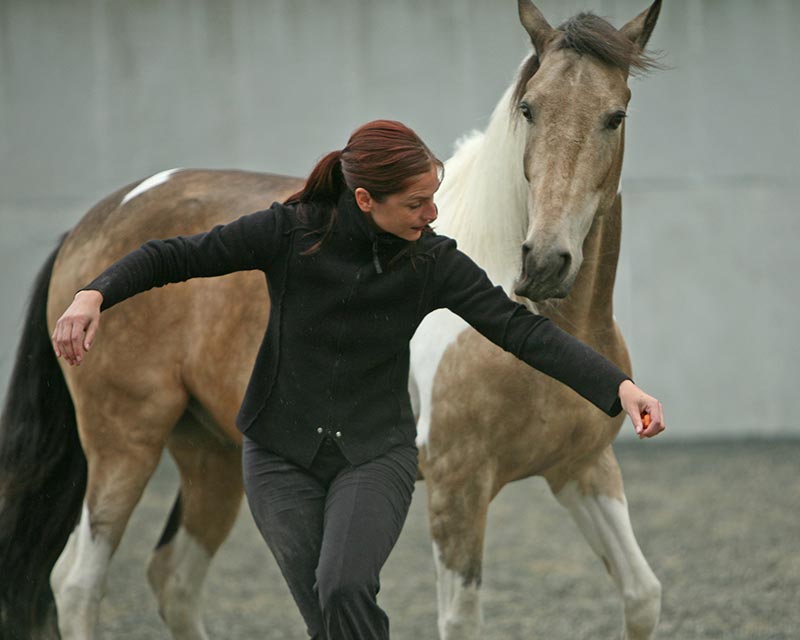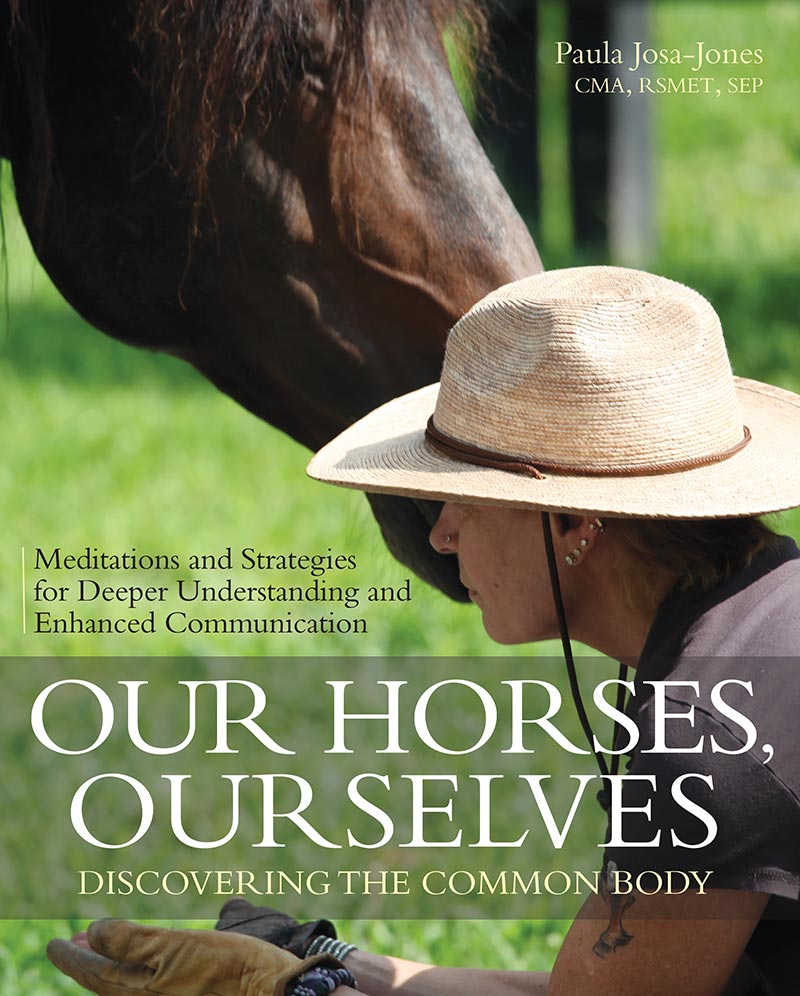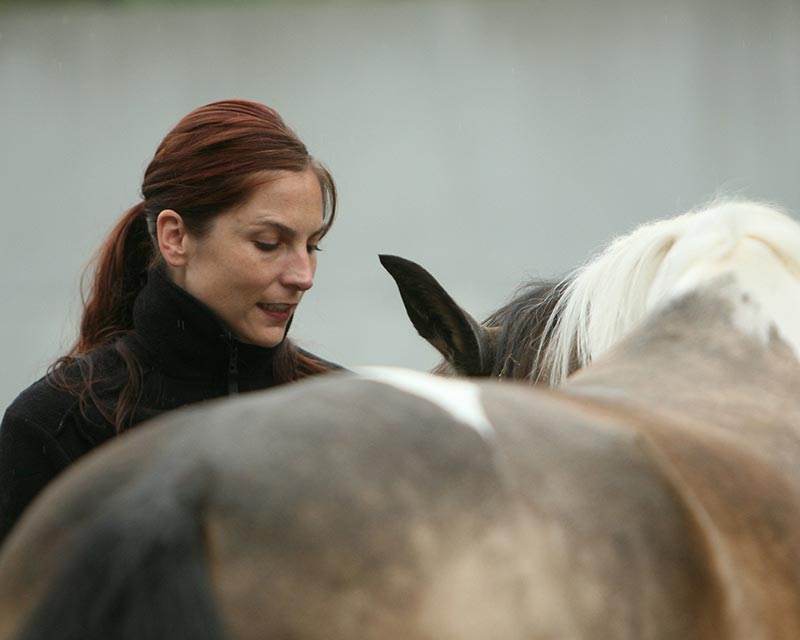
by Paula Josa-Jones
One of my teachers, the horseman Mark Rashid, is a black belt Aikido master and guides his students from the perspective that riding, like Aikido, is hard because you have to change yourself, and that it works well if you get yourself right. Through my life as a dancer and a choreographer—and a horsewoman—I’ve discovered how body-mind practices can help you get yourself right, so that when you are with your horse, you can listen to him and approach him from a place of generous and good intention, as well as an active awareness of what and how we are communicating from moment to moment.
Learning to connect with horses in this way teaches us how to develop our inner selves, become more comfortable in our own skin, be more trustworthy to ourselves and others, and gain greater skill, sensitivity, and resilience in social communication. This benefits our personal and work lives, sometimes in profound ways. Horses can help soften physical resistance and open wells of enthusiasm and creativity. Horses can help us learn that losing and finding balance is an integral part of life’s dance. That we can, like surfers, find, lose, and re-find balance on the crests and troughs of even the biggest waves, the most turbulent emotional and physical waters. They can help us to release our fears, our hesitancy, and become comfortable “on the edge,” where answers and inspiration arise spontaneously from an open, curious, and attentive mind and body.

I have collected meditations and strategies in my book Our Horses, Ourselves: Discovering the Common Body, which all intend to nourish some aspect of getting yourself right and then getting right with your horse, because it is there, in that relationship, that we can find the means to overcome physical and emotional limitations. We can discover the horse as shelter, a place of refuge and support, as well as the gateway to regularly attaining pleasure and joy.
Finding a means to better en¬gaging the horse’s cooperation provides you with the tools you need to engage a human partner or employee’s cooperation. The right exercises introduce skills that can ultimately help your help the horse or human that avoids, tunes out, or refuses to connect. They hone a sense of when to move and when to wait, teaching you to be a better listener, and more creative and resourceful in your training and riding and leading at home or in the workplace.
The meditations and strategies I rely on grew from many years of dancing, riding, teaching, and “working the clay” of my own body in partnership with my dancers and students and horses. They are not a checklist, but are meant to be consumed slowly, savored, and returned to as often as desired. What that means is that you may stay with one exercise for a day, a week, a month. They are about deepening feeling and expression in your body, helping you to create greater physical and emotional balance, thus opening new doors of communication with others, whether horse or human.
They will help to:
- Develop a consistent feeling of softness and connection in all aspects of your life and your horsemanship.
- Learn how to track your own body and increase its sensitivity, enjoyment, resilience, and wisdom.
- Build feelings of confidence, mindfulness, and a spirit of improvisation.
- Connect with your horse using bodily practices that are intuitive and playful, both on the ground and in the saddle.
- Create physical and emotional balance for both you and your horse.
Now Try This Exercise:
HELPING, NOT MAKING (10-15 MINUTES)
PURPOSE: In riding (and in our human relationships) sometimes control overshadows communication; harshness and impatience displace softness and connection. We are riding by making statements and declarations, forgetting to ask the questions. Learning to practice self-compassion and self-help can teach us to become more generous and patient in our relationships with our horses and with other humans. Learning to listen to our own bodies helps us listen to others.
- From a standing position, slowly lower your body to the floor, settling on either your right or left side. Let the body yield deeply into the floor, seeking ease and comfort. As you settle, breathe gently into this restful connection. When you feel the need, shift slowly to another comfortable position, using your hands and arms to help protect your joints from bumping the floor. Again, settle deeply and comfortably. Ask yourself how you could be more comfortable and make those adjustments.
- Begin to rise slowly to a standing position. Instead of pushing yourself up quickly, go slowly, helping your body move in a smooth and supported way to standing. Pause along the way. Look for a leisurely, unhurried feeling. You are not “making” yourself stand, you are “helping” your body find the most easeful and gentle way to rise.
- Repeat this sinking and rising a couple times, letting your movement be slow and languorous, each time discovering more ways to help your body change level and position on the floor with greater ease and flow.
In a workshop with Linda Tellington-Jones, I watched as another attendee brought her horse into the arena, dragging him behind her like a bag of heavy sand. She looked frustrated and angry, and more than a little embarrassed by her horse’s “bad behavior.” Tellington-Jones took the line from the student and showed her how to lead the horse with an enthusiastic “Let’s do it!” attitude, instead of a demanding, “Do it!” The change was immediate as Tellington-Jones playfully invited the horse to join her at the walk, and he relaxed, stepping forward with her easily.
As a choreographer, I am used to telling dancers where to move, what kind of movement I am looking for, and what needs more or less “juice.” Over the years I have learned that when my direction is infused with the “Let’s do it!” feeling, the results from my dancer-collaborators are confident and generous. When I am anxious or frustrated, the whole process of working with others becomes strained and “sticky.” It is the same with the horse, whether in the saddle or on the ground: If I respond to my horse with anxiety, fear, or anger—if I think, “Do it!”—that is what will be reflected back to me, rather than playfulness, openness, ease, and flow.

Now Try This Exercise:
LET’S DO IT! (5 MINUTES)
PURPOSE: Bringing a quality of “Let’s do it!” to your horse and to your other interactions with humans and animals in your life invites qualities of enthusiasm and playfulness to those relationships.
- Begin walking, and as you walk, mentally repeat the words, “Do it!” over and over. Imagine a stern quality in your voice, like a scolding coach or an angry parent urging you on. Notice your body and your emotions. Does your body feel heavy or tight? Do you feel resistant or frustrated?
- Now turn to face a different direction and breathe in and out in a soft, easy rhythm, three or four times.
- Start walking, mentally saying the words, “Let’s do it!” with a quick, eager quality, as if you were being invited to dance by a playful partner. What shifts do you sense in your emotions and body? Is there more lightness and ease in your step?
This excerpt from Our Horses, Ourselves: Discovering the Common Body by Paula Josa-Jones is reprinted with permission from Trafalgar Square Books (www.horseandriderbooks.com).

































